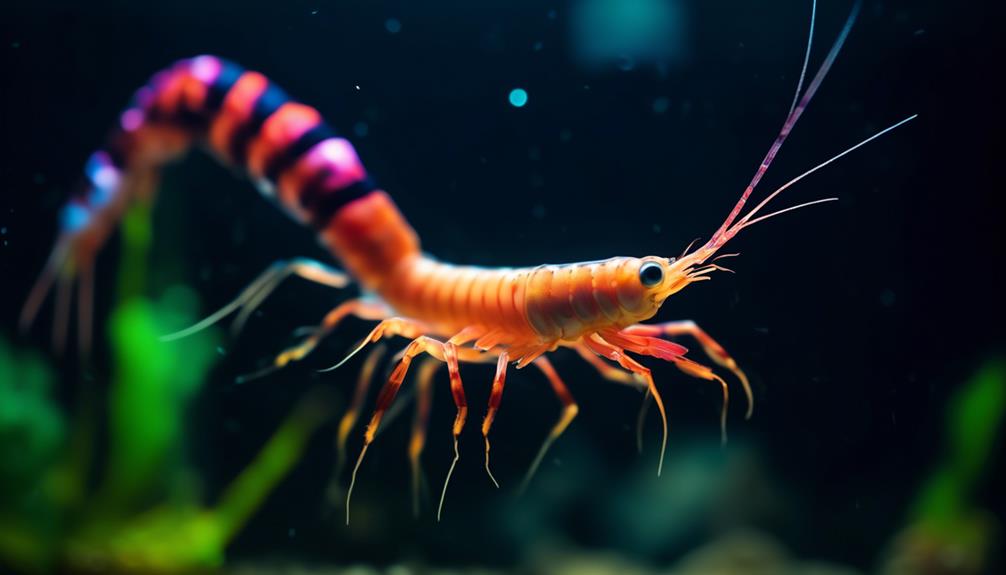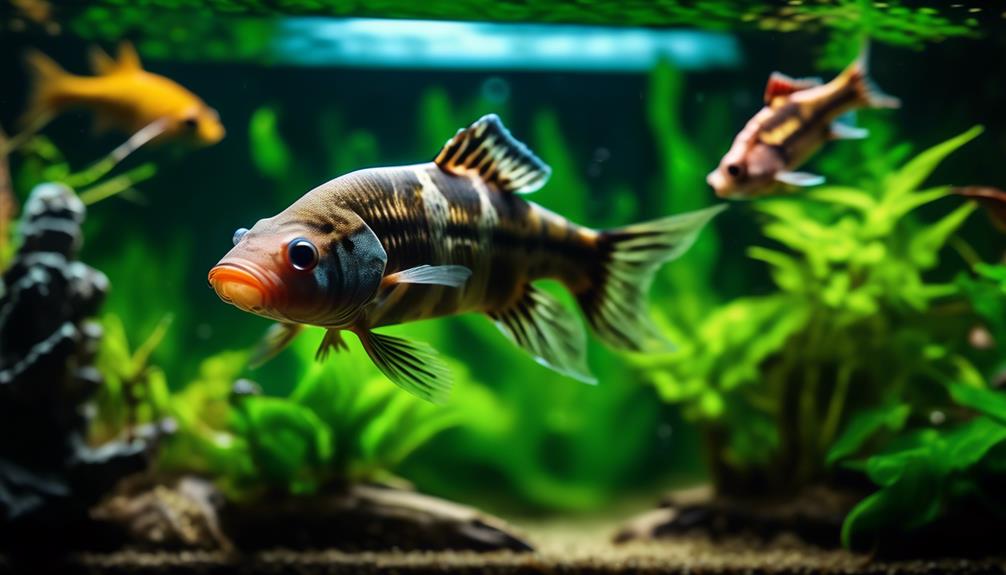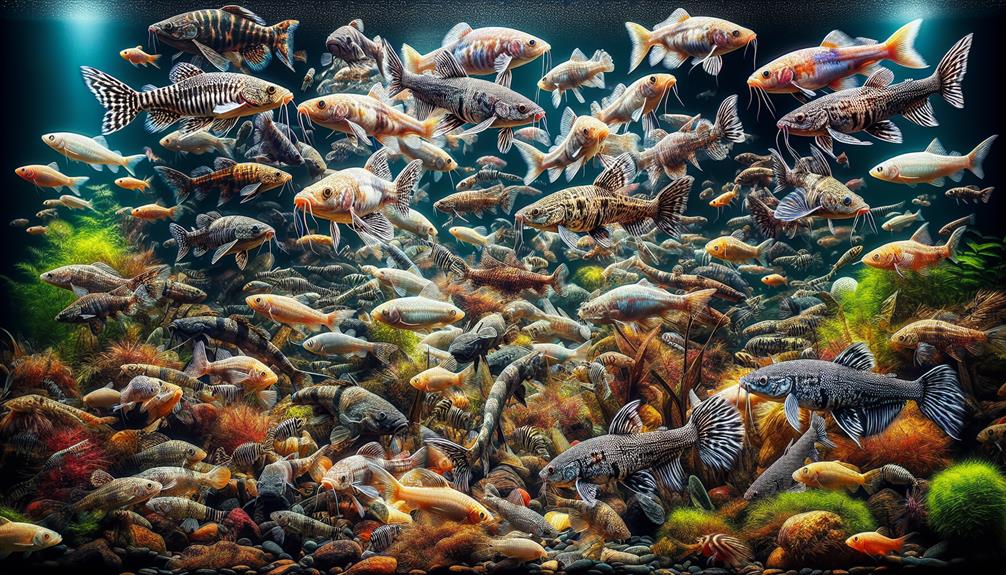Freshwater aquariums offer a captivating glimpse into the vibrant world of aquatic life. Among the many factors that contribute to a thriving aquarium, the inclusion of bottom dwellers is crucial for maintaining a balanced ecosystem. These creatures, with their unique abilities and characteristics, play an essential role in keeping the tank clean and harmonious.
From sand-sifting geophagus and nocturnal synodontis lucipinnis to scavenging loaches, cleaning shrimp, and personable corydoras, there is a diverse range of must-have bottom dwellers that can enhance both the visual appeal and functionality of your aquarium.
But which of these fascinating creatures will best suit your aquarium's needs? Let's delve into the topic and uncover the must-have bottom dwellers that will add charm and practicality to your freshwater aquarium.
Key Takeaways
- Geophagus and Synodontis Lucipinnis are larger fish that are excellent for cleaning the bottom of the tank.
- Loaches, such as Clown Loach and Kuhli Loach, are scavengers that can be easily integrated into your tank and help clean the substrate.
- Shrimp are colorful and efficient cleaners that occupy the bottom of the tank, but they should not be kept with larger fish.
- Corydoras, in various varieties like Green Laser Corydora, are small and personable bottom-dwelling fish that scavenge the tank and are best kept in groups.
Geophagus and Synodontis Lucipinnis
Geophagus and Synodontis Lucipinnis are two fascinating species of bottom-dwelling fish that offer both beauty and functionality to freshwater aquariums.
Geophagus, also known as sand-sifters or earth-eaters, are larger fish ranging from 6-10 inches. They come in various varieties, some more aggressive while others are peaceful. Geophagus have a tendency to dig up plants, so it is advisable to protect them with large rocks.
On the other hand, Synodontis Lucipinnis, a member of the catfish family, is about 3 inches long and exhibits a unique appearance, resembling a swimming shark. Synodontis Lucipinnis prefers to hide and is primarily active during the night. It is excellent at cleaning the bottom of the tank.
Keeping geophagus and Synodontis Lucipinnis together in a tank offers several benefits. Their behavior can be compared, as the geophagus dig and sift through the substrate while the Synodontis Lucipinnis actively cleans the bottom. This combination ensures a clean and well-maintained tank.
Loaches
Loaches, a diverse group of scavengers, are an excellent addition to freshwater aquariums due to their ability to clean the bottom of the tank and integrate well with other tank mates. Here are three key points to consider about Loaches:
- Clown Loach: This active species thrives in big groups and efficiently cleans the tank's bottom by sifting through the substrate. They are also known for their playful behavior, making them a delightful addition to any aquarium.
- Kuhli Loach: With a smaller size of about 3 ½ inches, Kuhli Loaches are nocturnal scavengers. They are best suited for tanks with dim lighting and plenty of hiding spots. These loaches will help keep the tank clean during the night hours.
- Dwarf Chain Loach: Active and well-suited for planted tanks, the Dwarf Chain Loach is an excellent choice for those who want a loach that also helps control snail populations. They have a unique behavior of intertwining themselves into a chain-like formation, which adds interest to the aquarium.
When selecting tank mates for loaches, it is essential to choose peaceful species that occupy different areas of the tank. Avoid aggressive or territorial fish that may harass or compete with the loaches for resources. With careful consideration, loaches can thrive and contribute to a healthy and vibrant aquarium ecosystem.
Shrimp

Shrimp, known for their vibrant colors and exceptional cleaning abilities, offer an excellent option for freshwater aquarium enthusiasts looking to enhance the bottom-dwelling aspect of their tank ecosystem. These small crustaceans act as cleaning powerhouses, diligently scouring the tank for food debris and algae, ensuring a clean and healthy environment for other tank inhabitants.
With their delicate appearance and striking colors, shrimp also serve as colorful additions that can add visual interest to the aquarium.
However, it is important to consider their compatibility with other tank mates. While shrimp can coexist with smaller and more peaceful fish species, they may be at risk of being eaten by larger fish. Therefore, it is advisable to keep shrimp in a tank with compatible mates or as solo dwellers to ensure their safety and well-being.
Corydoras
Corydoras, a diverse group of small bottom-dwelling fish, are renowned for their scavenging abilities and make an excellent addition to any freshwater aquarium. Here are three key points to consider when it comes to Corydoras:
- Breeding habits: Corydoras are known for their interesting breeding habits. They are egg layers and typically deposit their eggs on flat surfaces, such as plant leaves or the aquarium glass. The male Corydoras will then fertilize the eggs, and both parents will take turns guarding the eggs until they hatch. It can be a fascinating process to observe in your aquarium.
- Tank setup: Creating the ideal tank setup for Corydoras is essential for their well-being. They prefer aquariums with soft substrate like sand or fine gravel, as it mimics their natural habitat. Providing hiding spots, such as caves or driftwood, is also important to make them feel secure. Additionally, Corydoras thrive in well-maintained tanks with stable water parameters and a temperature range of 72-79°F (22-26°C).
- Diet and feeding: Corydoras are omnivorous and have a varied diet. They will readily consume algae, small insects, worms, and even commercial fish food. It's essential to provide a balanced diet that includes both live and dry foods to ensure their nutritional needs are met. Feeding them small amounts multiple times a day is recommended, as they have small stomachs and prefer to graze throughout the day.
Other Bottom Dwellers

Other bottom-dwelling species of fish that can be considered for freshwater aquariums include a variety of catfish, such as the popular Plecostomus and the armored Corydoras. These bottom dwellers contribute to creating a balanced ecosystem within the aquarium, as they play a crucial role in maintaining the cleanliness of the tank.
Plecostomus, also known as 'plecos,' are known for their ability to clean algae off the walls and substrate of the tank. They are large fish, ranging from 6 to 10 inches in size, and their presence adds visual interest to the aquarium.
Corydoras, on the other hand, are smaller catfish that come in various varieties, such as Corydoras Labrosus and Albino Corydoras. They scavenge the bottom of the tank, helping to keep it free of debris and leftover food.
Including these top 5 bottom dwellers, such as Plecostomus, Corydoras, Geophagus, Synodontis Lucipinnis, and Loaches, in your freshwater aquarium will contribute to the overall health and cleanliness of the tank. By incorporating these species, you can create a balanced ecosystem where each fish has its role in maintaining the well-being of the aquarium.
Frequently Asked Questions
Can Geophagus and Synodontis Lucipinnis Be Kept Together in the Same Tank?
Geophagus and Synodontis Lucipinnis can be kept together in the same tank, as long as the tank is large enough to accommodate their sizes and they are provided with ample hiding places. Both species are excellent bottom dwellers and can coexist in community tanks.
Do Loaches Require Any Special Care or Feeding Requirements?
Loaches are scavengers that can be easily integrated into your freshwater aquarium. They have different feeding habits depending on the species, but generally, they will eat both live and frozen foods. Loach compatibility with other fish should be considered to ensure a harmonious tank environment.
How Often Do Shrimp Reproduce and How Can I Control Their Population in My Tank?
Shrimp reproduce regularly, with the frequency varying depending on the species. To control their population in your tank, consider introducing natural predators, maintaining a balanced ecosystem, or removing excess shrimp manually.
Are There Any Specific Tankmates That Should Be Avoided When Keeping Corydoras?
When keeping Corydoras in your freshwater aquarium, it is important to avoid aggressive tankmates. Corydoras thrive in a peaceful environment and are best kept with non-aggressive fish that won't harass or outcompete them for food. Proper tank setup and compatible tankmates are crucial for their well-being.
Are There Any Unique Behaviors or Characteristics of Bottom Dwellers That I Should Be Aware of Before Adding Them to My Aquarium?
Bottom dwellers, such as Geophagus and Synodontis Lucipinnis, exhibit unique feeding habits and hidden camouflaging techniques. They are excellent at cleaning the tank's bottom, scavenging for food, and providing a visually appealing aspect to the aquarium.
Conclusion
In conclusion, incorporating bottom dwellers into your freshwater aquarium is essential for maintaining a healthy and balanced ecosystem. Geophagus and synodontis lucipinnis contribute to the cleanliness of the tank through their sand-sifting abilities and unique nocturnal habits.
Loaches and shrimp provide valuable services in scavenging and cleaning, respectively. Corydoras add charm and a sense of community to the aquarium.
By including these must-have bottom dwellers, you can create a thriving and harmonious freshwater aquarium. An interesting statistic to note is that over 60% of aquarium enthusiasts consider bottom dwellers to be an integral part of their tank ecosystem.

